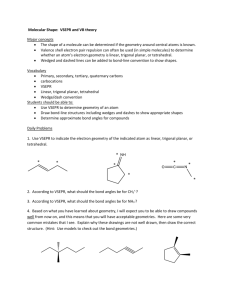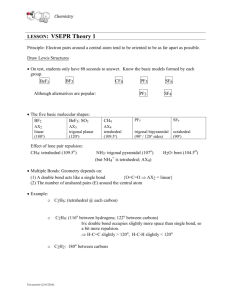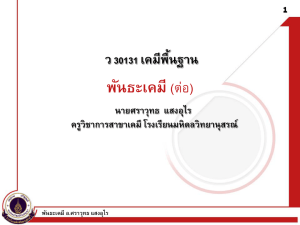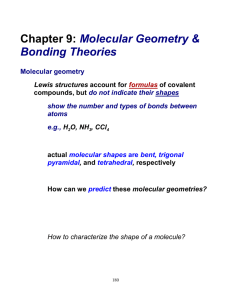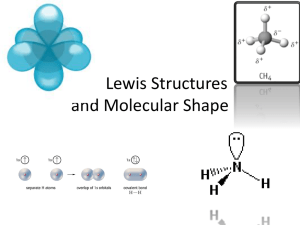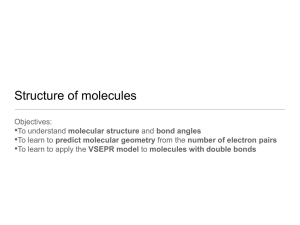VSEPR Theory and Molecular Geometries
advertisement
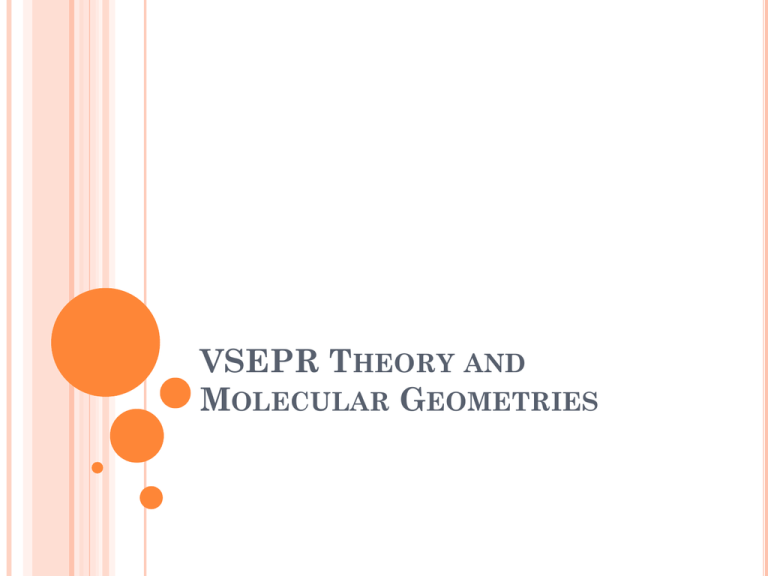
VSEPR THEORY AND MOLECULAR GEOMETRIES VSEPR THEORY VSEPR (pronounced “vesper”) stands for: Valence Shell Electron Pair Repulsion It attempts to explain the 3-D shapes of molecules. How do we know what molecules look like? X-Ray Crystallography X-rays are fired through a crystallized sample of a substance and are diffracted in many directions. By carefully studying the directions and intensity of the diffracted X-rays, a crystallographer can tell a lot about the locations of atoms within the crystal. Remember, theories explain observations! VSEPR Theory explains the observed shapes of molecules. X-RAY CRYSTALLOGRAPHY VSEPR THEORY The basic principles of VSEPR Theory: Electron pairs repel each other. Electron pairs in molecules tend to arrange themselves so as to minimize the repulsion between them. In other words, get as far apart as possible. THE GEOMETRY OF CH4 Based on the Lewis structure of methane, you might expect the geometry on the left. VSEPR theory predicts the geometry on the right. The geometry on the right is confirmed by observations. 90º H HCH H 109.5º The spheres represent the centers of the carbon and hydrogen atoms. VSEPR FORMULAS Lewis structures do not show geometry, only electron pair placement. However, the 3-D shape (geometry) of a molecule can be determined from a properly-drawn Lewis structure. All monocentric molecules can be represented by a VSEPR formula: AXE A = central atom X = outer atoms (doesn’t matter what they actually are or how many bonds they are held by) E = lone pairs of electrons on the central atom only. VSEPR FORMULAS What VSEPR formula corresponds to the chlorate ion, ClO3-1? First draw a proper Lewis structure: Needed = 32 Available = 26 Shared = 6 -1 O O Cl O One central atom, three outer atoms, one lone pair: AX3E VSEPR FORMULAS What VSEPR formula corresponds to sulfur trioxide, SO3? Draw a Lewis structure. Needed = 32 Available = 24 Shared = 8 O O S O 1 central atom, 3 outer atoms, no lone pairs: AX3 MOLECULAR GEOMETRIES Each VSEPR formula corresponds to a certain molecular geometry. There are six possible geometries for molecules whose central atoms obey the octet rule. MOLECULAR GEOMETRIES VSEPR Formula: AX2 Geometry: Linear Bond Angle: 180º Example: CO2 O C O MOLECULAR GEOMETRIES VSEPR Formula: AX3 Geometry: Trigonal Planar Bond Angle: 120º Example: SO3 O O S O MOLECULAR GEOMETRIES VSEPR Formula: AX4 Geometry: Tetrahedral Bond Angle: 109.5º Example: CCl4 Cl Cl C Cl Cl MOLECULAR GEOMETRIES VSEPR Formula: AX2E Geometry: Bent (Angular) Bond Angle: Less than 120º Example: SO2 O S O MOLECULAR GEOMETRIES VSEPR Formula: AX3E Geometry: Trigonal Pyramidal Bond Angle: Less than 109.5º Example: NH3 H H N H MOLECULAR GEOMETRIES VSEPR Formula: AX2E2 Geometry: Bent (Angular) Bond Angle: Less than 109.5º Example: H2O H O H
